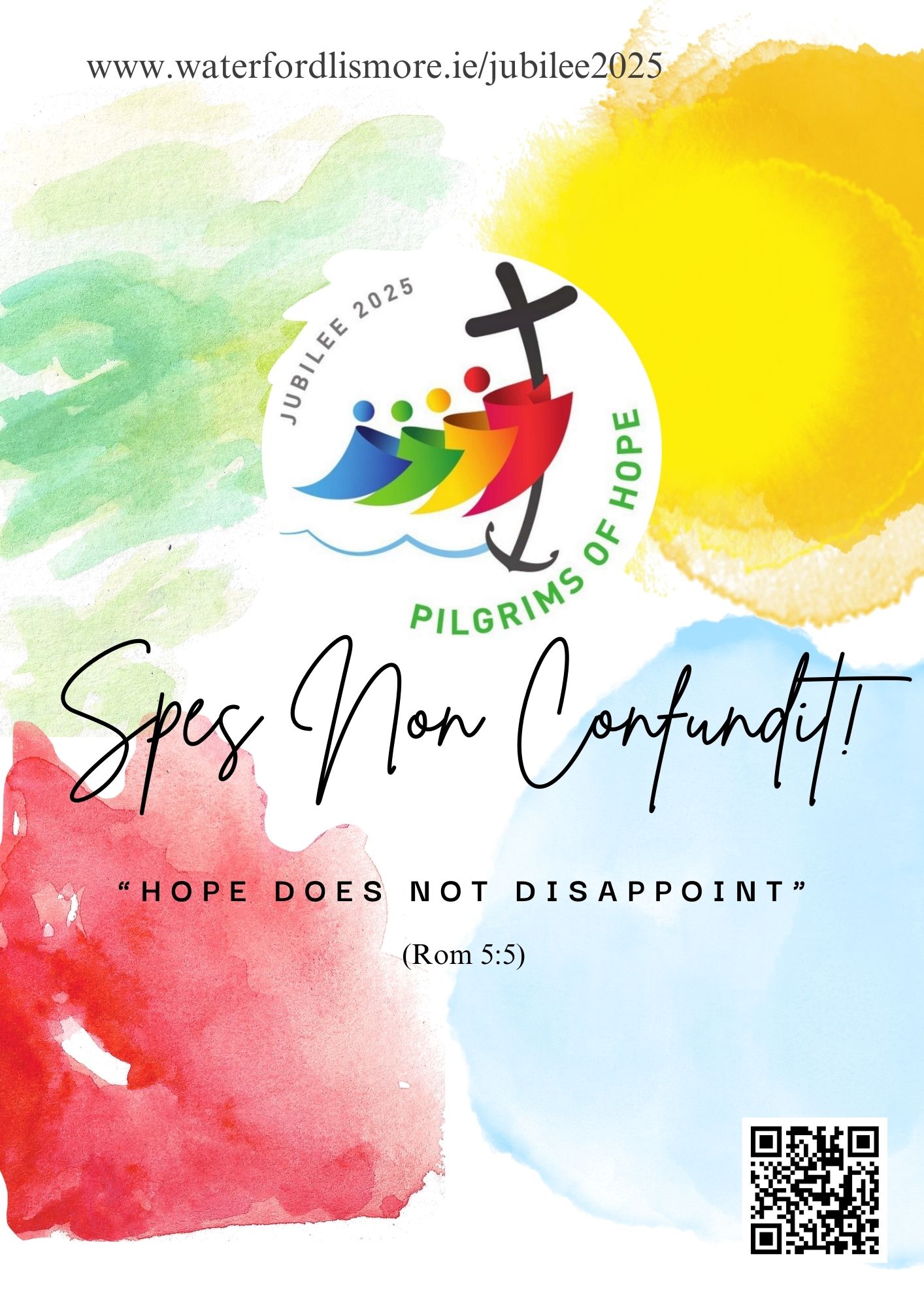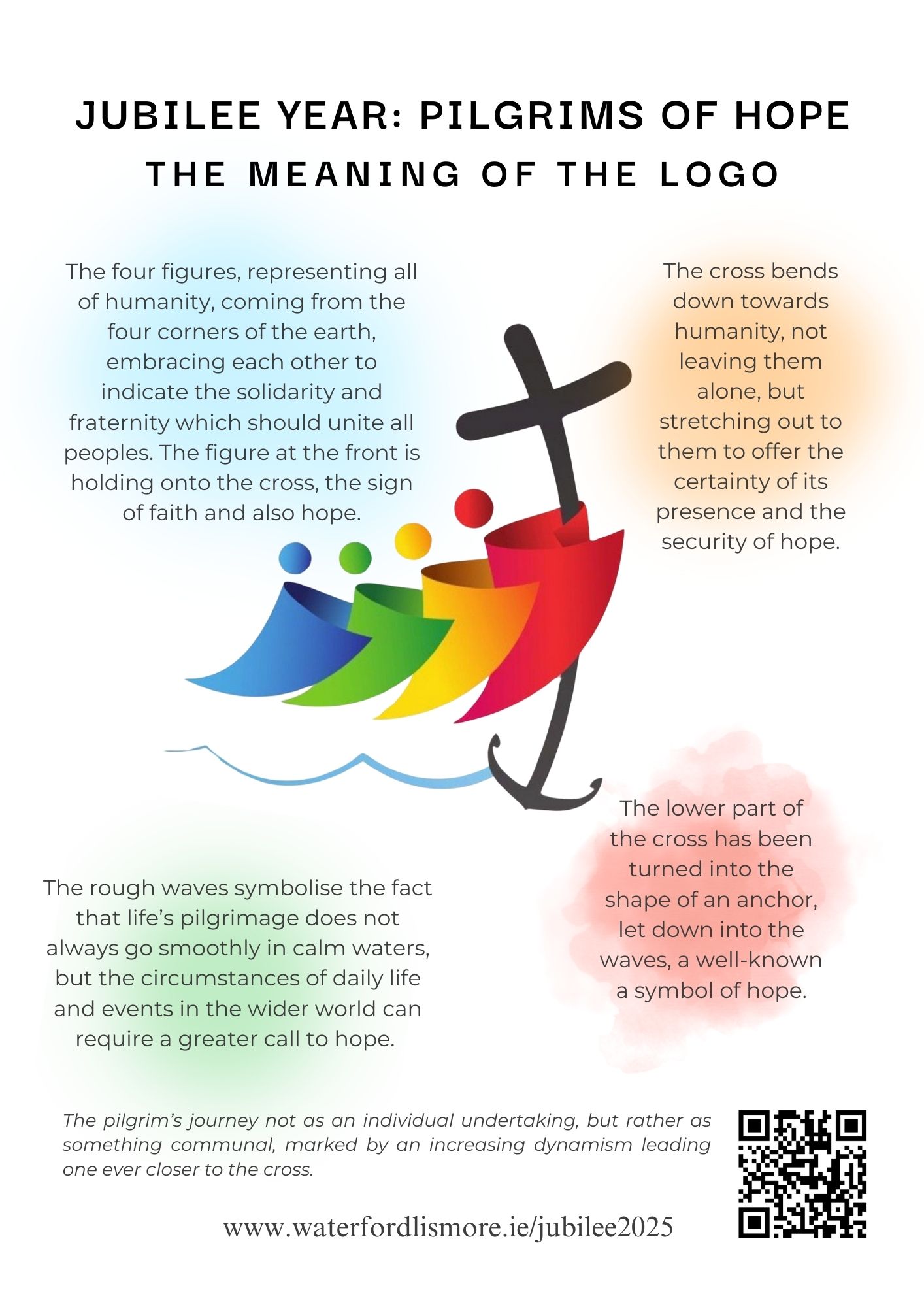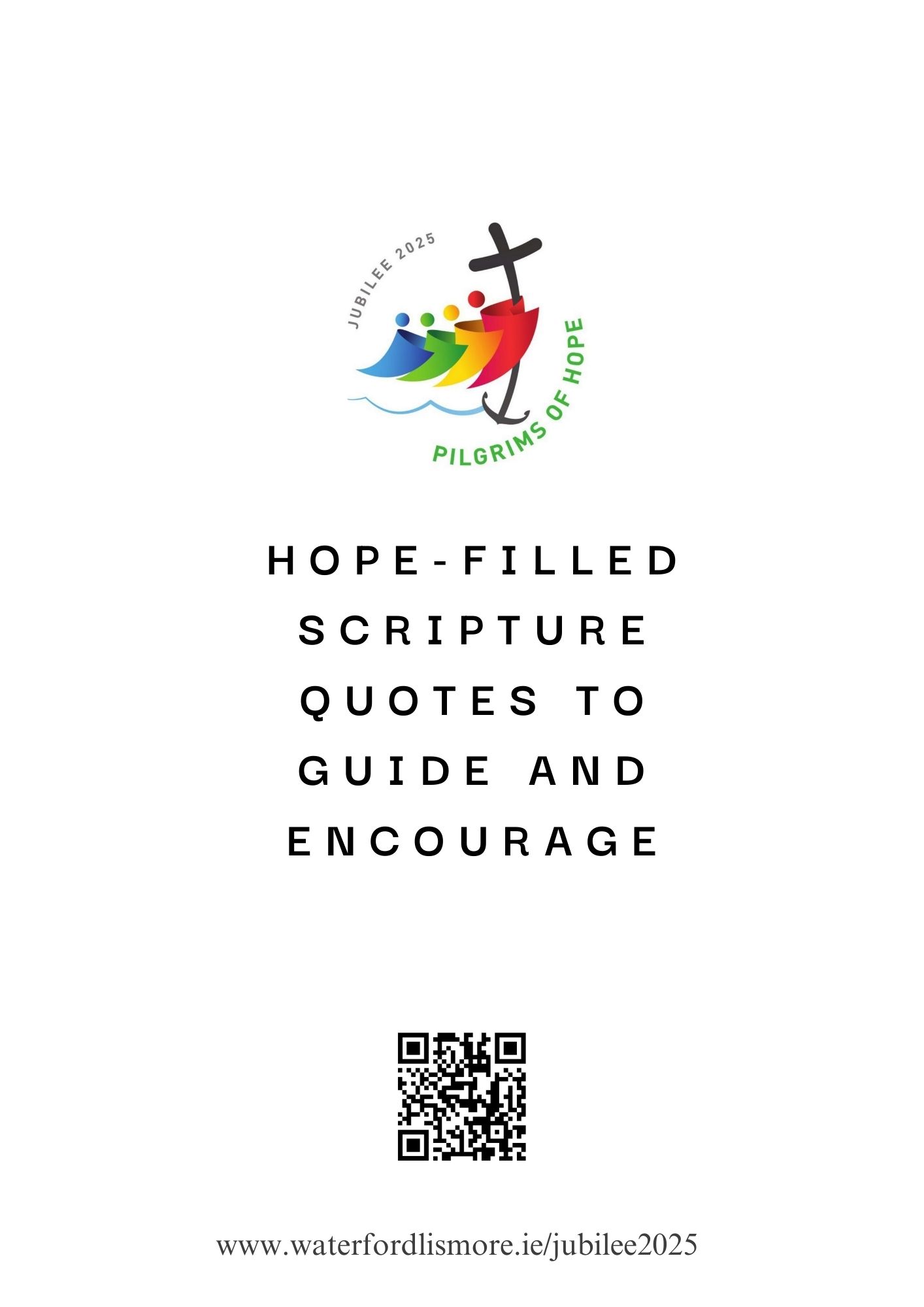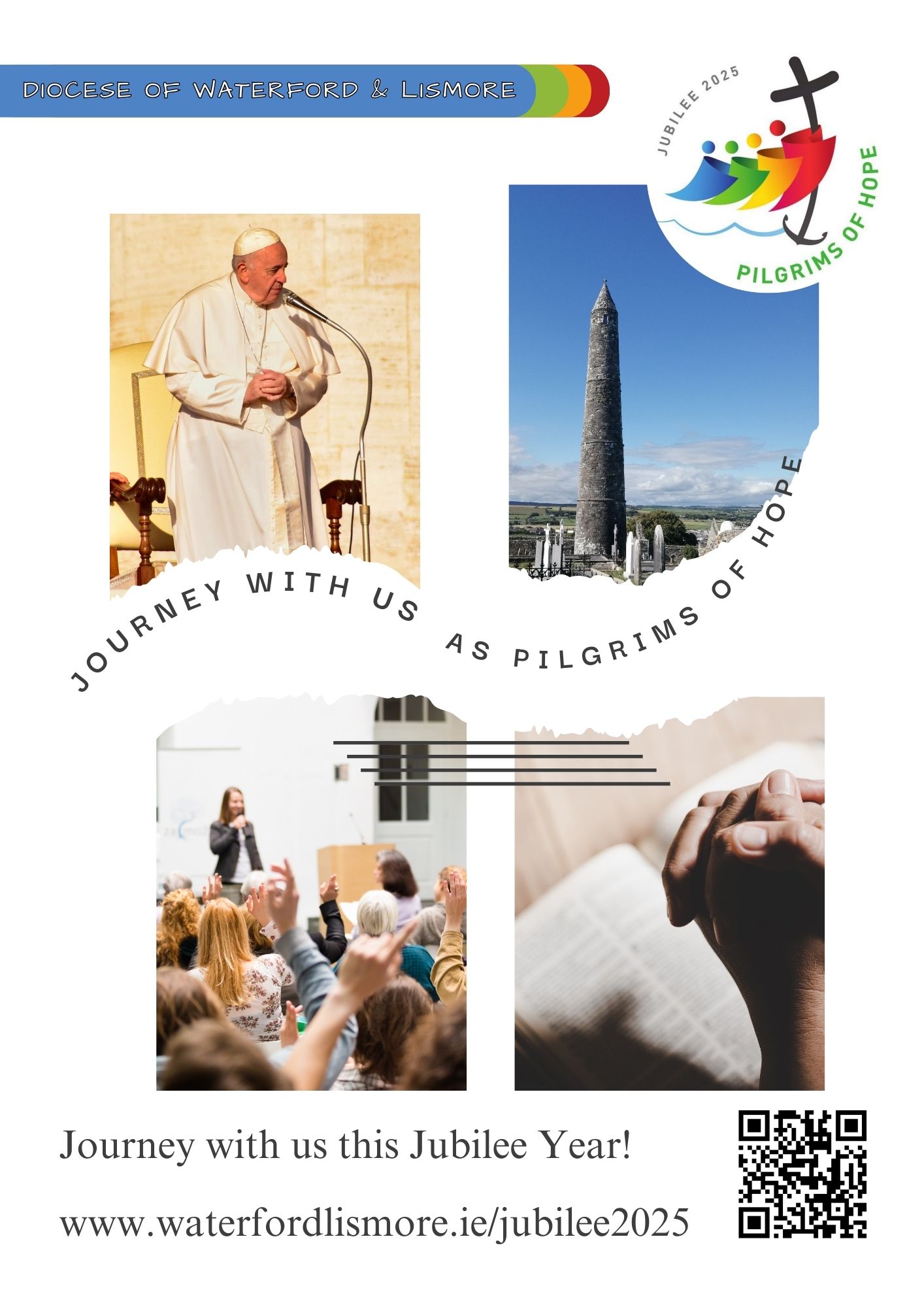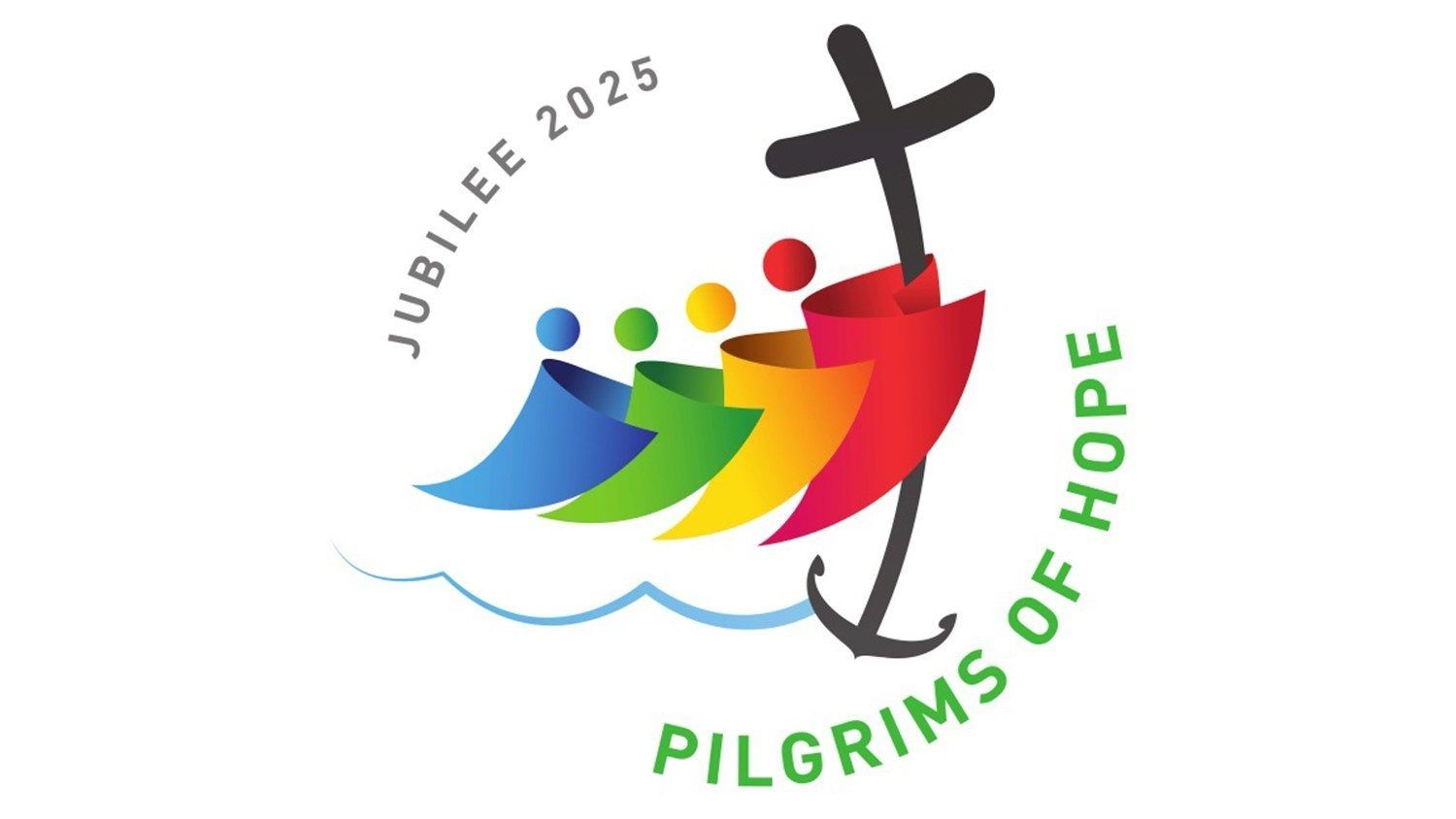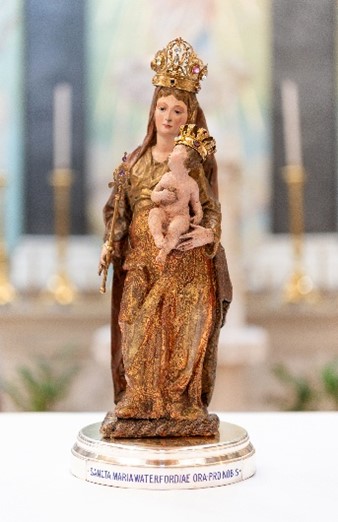
What is a Jubilee Year?
A Jubilee Year is celebrated by the Church every 25 years. This Jubilee Year begins on Christmas Eve 2024 and concludes on 6 January 2026.
In the Catholic Church, a Jubilee or Holy Year is a special year of forgiveness and reconciliation, in which people are invited to come back into right relationship with God, with one another, and with all of creation.
Theme: “Pilgrims of Hope”
Pope Francis has invited Catholics to renew our hope and discover a vision that can “restore access to the fruits of the earth to everyone.”
“Pilgrimage is of course a fundamental element of every Jubilee event. Setting out on a journey is traditionally associated with our human quest for meaning in life.” (Pope Francis)
Jubilee Calendar of Events in the Diocese
The Jubilee Year is an opportunity to respond to God’s call to turn to him and to pursue justice. Throughout the Jubilee Year and in locations across the diocese and in parishes there will be a wide range of activities and events for all ages across connected with specific areas of Jubilee.
For Parish events – check Parish social media / website / newsletter for more up-to-date details.
December 2024
- Opening of Jubilee Year – Rome (24th December).
- Decorating of Church doors across the diocese with Jubilee logo & explanatory poster. Distribution of Jubilee Prayer Cards across the diooese.
- Official Diocesan Launch of Jubilee Year in Cathedral of the Most Holy Trinity (29th December)
January
February
- Jubilee of the Sick and Health Care Workers: February 11th: World Day of the Sick – distribution of Healing Prayer Cards across the diocese
- Pastoral Visits by Bishop Phonsie to discuss the Jubilee Year
- Songs of Hope: Sunday 16th February at the Cathedral of the Most Holy Trinity at 5pm: Choirs from around the Diocese participating.
- Zoom Formation Series: “Power and Grace: Discovering the Sacraments”. Feb 18th – March 11th (Tuesdays 8 – 9.30pm on zoom)
March
- Jubilee of the World of Volunteering
- Pilgrims of Hope Prayer Spaces Experience / Training Session at St John’s Pastoral Centre: 12th March
- Jubilee of Teenagers: TY REvive Conference at SETU Arena, Keynote speaker: Elma Walsh
- Public Talk by Elma Walsh (mother of the late Donal Walsh): “Living with Hope” – Thursday 27th March (St John’s Pastoral Centre, John’s Hill, Waterford X91 HW9D)
- Pilgrimage to Assisi & Rome: Spiritual Director Fr Michael Toomey. March 30th – April 5th. More info on www.joewalshtours.ie
April
- Jubilee of Teenagers: REvive TY Hike
- Canonisation of Blessed Carlo Acutis in Rome on 27th April (for more on Carlo Acutis click here) – moved to September 7th
- A Dawn Mass will be celebrated at the Grotto in the grounds of Butlerstown Church, Waterford on Easter Sunday Morning commencing at 6am, to celebrate the Jubilee Holy Year.
May
- Closing date for entries to Jubilee Schools Art Competition: 8th May
- Annual Diocesan Pilgrimage to Knock (in conjunction with Tuam Diocese): Sunday 4th May
- Jubilee of Teenagers: Pope John Paul II Pilgrimage to Medjugorje: 3rd – 10th May
- Jubilee of Families, Children, Grandparents and the Elderly: Diocesan Jubilee Family Day at Holy Family Mission – 18th May. Click to register
- “Prayer in the Square” Rosary Rally in Clonmel Plaza – Saturday 24th May 4pm
- Rosary Procession and May Crowning in Dungarvan, Sunday 25th May at 2pm
- Rosary Procession and May Crowning in Waterford, Sunday 25th May at 3pm
- “Prayer in the Square” – 24 Hours Adoration in John Roberts Square, Sunday 25th May (beginning with 12 noon Mass) until noon on Monday 26th May. All welcome.
June
- Diocesan Pilgrimage to Lourdes: 4th – 9th June
- Jubilee of Priests: Trinity Sunday.
- 40 Hours Adoration in St Anne’s Church, Ballylaneen (17th – 18th June)
- 40 Hours of Eucharistic Adoration will begin in St. Paul’s Church, Lisduggan, Waterford at 4.30pm on Friday 20th of June and will continue until 8.30am on the Feast of Corpus Christi, Sunday the 22nd of June. All are welcome to visit the church at any time during this period.
- Corpus Christi Process – Clonmel – 19th June
- Corpus Christi Procession – Waterford (and other parishes): 22nd June
- Jubilee of the Armed Forces, Police, Security Personnel and Emergency Services Event at Clonmel Plaza on Sunday 29th June 2 – 4pm. More info to follow.
July
- Blessing of newly completed mural of Our Lady of Waterford at the Cathedral of the Most Holy Trinity, 12th July
- Jubilee of Youth: Frassati Young Adult Camino (St Declan’s Way) – in association with the Archdiocese of Cashel & Emily. July 31st – August 4th
August
- Jubilee of Youth: Frassati Young Adult Camino (St Declan’s Way) – in association with the Archdiocese of Cashel & Emily. July 31st – August 4th
- Parish of Kilgobinet, Colligan Kilbrien: Mass and celebration at The Cross of Hope and Peace, Cruachán: Sunday 10th August.
- Jubilee Communion of Reparation Vigil: Kilmacthomas – 22nd – 23rd August.
- Jubilee of Artists: In collaboration with Waterford Gallery of Art, a tour of the ‘Faith in the Process’ exhibition of artworks from the Waterford City Art Collection, on religious themes, will take place on 28th August at noon. Meeting outside the Cathedral at 11.30am. Please email [email protected] for more details
September
-
- Canonisation of Carlo Acutis and Pier Giorgio Frassati in Rome: September 7th
- Parish of Killea, Crooke & Faithlegg Jubilee Pilgrimage Walk to the Cathedral of the Most Holy Trinity on 13th September
- Jubilee Communion of Reparation Vigil: Kilmacthomas 12th – 13th September
- Kilrossanty & Fews Parish: Parish Pilgrimmage hiking up the Holy Year Cross mountain, Kilrossanty. Feast of the Exaltation of the Holy Cross, 21st September 2025. Details to follow
October
- Jubilee of Consolation Presentation by Deacon Lazarus Gidolf: Wed 1st October at 7pm in St Oliver’s Pastoral Centre, Clonmel. “From Heartache to Hope” – Consolation for Our Lives and Families
- Clonea-Rathgormack Parish Evening of Music and Prayer with James Kilbane: Fri 3rd October
-
Jubilee Celebration: Evening of Prayer and Music: The Pastoral Areas of Lismore, Knockanore, Ballysaggart, Tallows, Ballyduff Upper, Cappoquin, Modeligo & Affane are presenting an Evening of Music and Prayer – Lismore Catholic Church, Friday 3rd October from 7pm – 8pm. All are invited and all are welcome!
- Mass of Installation of First Class Relic of St Carlo Acutis at Ardfinnan Church, 12 noon on Sunday 12th October
- Diocesan Eucharistic Adoration Retreats: October 5th, 12th & 26th, 2 – 5pm
- Jubilee of the World of Education: REnewal Conference for RE Teachers, Chaplains, Principals and TY Coordinators.
- Jubilee of Consecrated Life: Mass in the Cathedral of the Most Holy Trinity, Waterford at 5pm on 9th October to celebrate the men and women religious of our diocese.
- Jubilee of Marian Spirituality: A Talk on the History of Our Lady of Waterford: St John’s Pastoral Centre, Waterford on 16th October at 7pm
- Jubilee of Consecrated life: October 8th
November
- Jubilee of Choirs: Songs of Hope: St Mary’s Clonmel
- Diocesan Jubilee Pilgrimage to Rome: 10th – 16th November
December
January
- Closing of Jubilee Year in Diocese: 4th January
Embracing Hope in the Jubilee Year: Pastoral Letter from Bishop Cullinan
The Jubilee Logo
The logo shows four figures stylised to indicate humanity coming from the four corners of the earth. They are embracing each other to indicate the solidarity and brotherhood which joins the peoples. The figure at the head is holding onto the cross. It is not only the sign of the faith which embraces, but also of the hope which can never be abandoned because we are always in need of hope, especially in moments of great need. It is helpful to observe the rough waves underneath; this indicates that life’s pilgrimage does not always move in calm waters. Life’s circumstances and the events of the world often demand a greater call to hope and because of this we see that the lower part of the cross has been turned into an anchor which stands out in the wave. As is well known, the anchor has often been used as a metaphor of hope and as a matter of fact, the anchor of hope is the name used in maritime jargon as the name given to the reserve anchor used by vessels involved in emergency manoeuvres to stabilise the boat during storms. Do not ignore the fact that the image demonstrates that the pilgrim’s journey is not individual, but communal and marked by a growing vitality leading one always closer to the cross, which is itself by no means static, but also dynamic. It turns towards humanity, not leaving it alone but going out and meeting it to offer it the certainty of its presence and the sureness of hope. Finally, the motto of the 2025 Jubilee Year: Pelegrinantes in Spem (Pilgrims in hope), is very visible in green.
https://www.iubilaeum2025.va/en/notizie/comunicati/2022/logo-giubileo-2025.html
The Jubilee Prayer
The Jubilee Prayer
Father in heaven,
may the faith you have given us
in your son, Jesus Christ, our brother,
and the flame of charity enkindled
in our hearts by the Holy Spirit,
reawaken in us the blessed hope
for the coming of your Kingdom.
May your grace transform us
into tireless cultivators of the seeds of the Gospel.
May those seeds transform from within both humanity and the whole cosmos
in the sure expectation
of a new heaven and a new earth,
when, with the powers of Evil vanquished,
your glory will shine eternally.
May the grace of the Jubilee
reawaken in us, Pilgrims of Hope,
a yearning for the treasures of heaven.
May that same grace spread
the joy and peace of our Redeemer
throughout the earth.
To you our God, eternally blessed,
be glory and praise for ever.
Amen
What and where is the "Holy Door"?
From a symbolic viewpoint, the Holy Door takes on a special significance: it is the most powerful sign of the Jubilee, since the ultimate aim of the pilgrim is to pass through it. The opening of the door by the Pope constitutes the official beginning of the Holy Year. Originally, there was only one door, at the Basilica of St. John Lateran, which is the cathedral of the Bishop of Rome. Later, to allow as many pilgrims as possible to take part in the Jubilee experience, the other Roman Basilicas also opened their own holy doors.
In crossing the threshold of the Holy Door, the pilgrim is reminded of the passage from chapter 10 of St John’s gospel: “I am the door. If anyone enters by me, he will be saved and will go in and out and find pasture.” Passing through the Holy Door expresses the decision to follow and be guided by Jesus, who is the Good Shepherd. The door is a passageway that ushers the pilgrim into the interior of a church. For the Christian community, a church is not only a sacred space, to be approached with respect, with appropriate behavior and dress code, but it is a symbol of the communion that binds every believer to Christ: it is a place of encounter and dialogue, of reconciliation and peace which awaits every pilgrim, the Church is essentially the place of the community of the faithful.
In Rome, this experience takes on a special significance because of the special links between the Eternal City and Saints Peter and Paul, the apostles who founded the Christian community in Rome and whose teachings and example are models for the universal Church. The tombs of Saints Peter and Paul are located in Rome, they were martyred here; and together with the catacombs, these sacred sites are places of continuous spiritual inspiration.
https://www.iubilaeum2025.va/en/giubileo-2025/segni-del-giubileo/porta-santa.html
Where will Holy Doors be opened?
Holy Doors will be opened by Pope Francis in:
- St Peter’s Basilica (Dec 24th)
- Saint John Lateran (Dec 29th)
- Saint Mary Major (Jan 1st)
- Saint Paul Outside-the-Walls (Jan 5th)
- Rome’s Rebibbia Prison (Dec 26th).
What is the Biblical background for a Jubilee Year?
“Jubilee” is the name given to a particular year; the name coming from the instrument used to mark its launch. In this case, the instrument in question is the yobel, the ram’s horn. In the Bible the Jubilee Year occurred every 50 years and involved the cancelling of debts, a period of rest for people and the earth, and land being restored to the landless.
In the Gospel of Luke, Chapter 4:14ff , Jesus makes clear his own mission is to bring Jubilee. In the synagogue at Nazareth he reads from the scroll of the prophet Isaiah, proclaiming the year of the Lord’s favour:
The Spirit of the Lord has been given to me, because he has anointed me to bring good news to the poor, to proclaim liberty to captives and recovery of sight to the blind, to let the oppressed go free, and to proclaim the Lord’s year of favour.” (Luke 4:18-19)
After reading, Jesus announces: “Today this scripture has been fulfilled in your hearing.” Jesus shows us what God’s Kingdom of justice, compassion and freedom looks like. He invites us to join him in making it a reality.
Official Hymn for the Jubilee
Towards the Jubilee Video
What is the Papal Bull of Indiction?
The term ‘bull’ originates from the lead seal, known as bulla in Latin. It refers to a Papal decree which outlines the purpose and spirit of the Holy Year.
What does the Papal Bull for the 2025 Jubilee Year tell us?
The Bull is titled “Spes non confundit” (Hope does not disappoint) and urges us to look for signs of hope in the world around us and work for peace and justice. In the document Pope Francis writes: “If we really wish to prepare a path to peace in our world, let us commit ourselves to remedying the remote causes of injustice, settling unjust and unpayable debts, and feeding the hungry.” (#16)
Jubilee Art Competition: Our Lady of Waterford
Our Lady of Waterford Jubilee Mural Competition for Schools: Click here for details!
For more info on Our Lady of Waterford – click here.
Where can I find more information?
- For more information, check out www.waterfordlismore.ie/jubilee2025
- Official Vatican site: https://www.iubilaeum2025.va/en.html
- Letter from Pope Francis
- Calendar of Major Events in Rome
Jubilee Year Pilgrim Path Passport
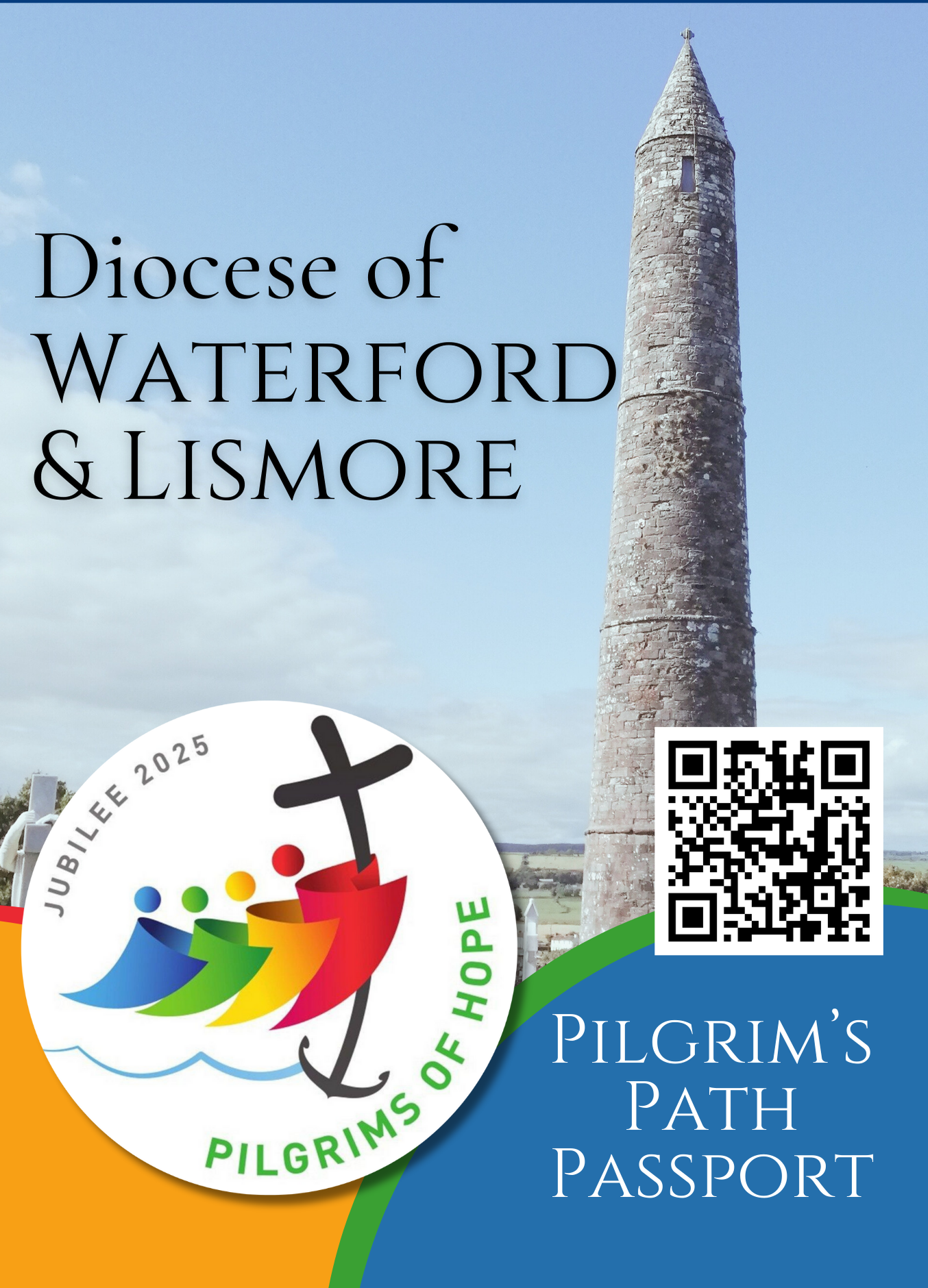 Follow the Diocesan Jubilee Pilgrim Trail and visit the designated sites in the Diocese of Waterford & Lismore.
Follow the Diocesan Jubilee Pilgrim Trail and visit the designated sites in the Diocese of Waterford & Lismore.
In this Jubilee Year, the late Pope Francis invited us to be Pilgrims of Hope. The Diocese of Waterford & Lismore Pilgrim’s Path Passport offers us a beautiful opportunity to be pilgrims in our own Diocese: why not gather friends and family to join you also? Seven sites across the diocese have been chosen by the people of the Diocese as Jubilee Year locations for pilgrimage and can be visited in any order and at any stage throughout the year. Passports are available in Churches throughout the diocese with an official launch by Bishop Cullinan on 1st June 2025 or you can download here and print at home too.
St Declan's Tower and Well
DECLAN’S MONASTERY – ARDMORE MONASTIC SITE founded by the Early Irish Saint, St. Declan
Ardmore Cathedral, Round Tower and Oratory are found in St Declan’s Monastery south-west of Ardmore, Co. Waterford. Ardmore is believed to be one of the oldest Christian settlements in Ireland. It was founded by an early Irish saint, St Declan, in the 5th century, prior to the arrival of St. Patrick to Ireland.
Ardmore cathedral was built between 1170 and 1210, on the site of the original monastery. It is recorded that Moelettrim Ó Duibherathra died in 1203, having finished the building of the church. The nave shows Romanesque arcading, a succession of continuous arches, with several Christian themes carved into the stones. Some of the depictions include Adam and Eve, the Judgement of Solomon, and the Adoration of the Magi. The chancel holds two of the three Ogham stones, while the nave hold seven medieval grave slabs and the original cap of the round tower.
The round tower is of 12th century construction with four floors and is 30m high. The tower was conserved in the 1840’s by Mr Odell. The round tower was accessed externally with a ladder to reach the first floor. Several of the internal supporting corbels are carved with grotesque faces. At the top of the tower, four windows mark the cardinal points of the compass. Having a round tower meant the monastery was very wealthy.
St Declan’s Oratory was renovated in 1716 by Dr Thomas Mills, Bishop of Waterford, and is intact as a result. Part of the renovation included the insertion of the north doorway, the original door at the west side, the stone roof was restored, the east window rebuilt, and the removal of an Ogham stone from the east gable end. It was traditionally thought to be the grave of St Declan and was where a small cross inscribed black stone was found in 1860 but is now lost.
Discover the Sacred Waters of St. Declan’s Well: A Journey Through History and Faith
Legend has it that St. Declan, who founded a seminary in Ardmore around 416 AD, used this very well as a baptistery long before St. Patrick arrived in Ireland in 431 AD. The well served as a vital spiritual hub for early Christians in the region, marking Ardmore as a significant centre of Christianization.
The Holy Well is adorned with three medieval stone crucifixions integrated into its modern masonry, symbolizing its enduring connection to faith. In the past, thousands gather at St. Declan’s Well to perform rounds or “stations” during the feast day on July 24th or the nearest Sunday. This vibrant tradition continues to draw pilgrims who believe in the healing powers of its waters.
The celebration surrounding St. Declan’s Well is known as Pattern Sunday, where visitors partake in rituals that blend ancient customs with Christian practices. Despite attempts to suppress these traditions over the years, they have persisted, showcasing the resilience of local culture and spirituality.
In 1900, thousands flocked to Ardmore to honour St. Declan, and even today, many pilgrims recount miraculous healings attributed to the well’s sacred waters. One local even shared how he was cured of an ailment that baffled doctors after visiting St. Declan’s Well!
St. Declan’s Well is more than just a historical landmark; it’s a living testament to faith, resilience, and community spirit that has thrived for centuries in Ardmore. Whether you seek healing, reflection or wish to immerse yourself in Ireland’s ancient traditions, visiting this sacred site promises an unforgettable experience steeped in history and spirituality.
Who was St. Declan?
St. Declan, a prince of the Decies Kingdom in Munster, was born in the 5th century. He was baptised by a priest named Colman, later to become St. Colman. When Declan was seven years old he studied under a sage called Dioma. This training continued for many years until Declan, taking with him some of his disciples, went to Rome for further instruction in Christianity. While in Rome the Pope consecrated Declan. Declan had a strong desire to return to Ireland and, according to legend, he had in his possession a miraculous black bell with which he summoned an empty vessel to carry him on his journey. The bell was placed in a rock and when Declan prayed the rock floated out to sea. He followed it and eventually, it led him to shore at Ardmore, Co. Waterford. There Declan worked conscientiously among the people and built a Church.
While returning to Ireland it is reported that Declan met St. Patrick. Declan and three other Bishops – Ibar, Cieran and Ailbe were evangelising in Ireland when St. Patrick arrived here. Declan did not confine his work to Ardmore and the Déise region but he also travelled further afield and especially to Cashel.
One of the most remarkable groups of ancient ecclesiastical remains in Ireland can be seen today in Declan’s well-loved Ardmore – a beautiful and perfect Round Tower, a singularly interesting ruined Cathedral, the ruins of a second Church beside a holy well, a primitive oratory and some ogham-inscribed pillar stones.
Declan is an outstanding example of a Saint whose cult has not only survived, but has recently shown a marked revival. This is demonstrated by pilgrims, visitors and local people who are proud of St. Declan and the strong faith that they have inherited.
The Faith of the Déise People: Michael G Olden
St Patrick's Holy Well
St Patrick’s Well is situated in a tranquil valley to the west of Clonmel, close to the village of Marlfield in County Tipperary. It is a picturesque setting for this holy site, which has been revered for centuries. There are over 3,000 holy wells in Ireland and St Patrick’s Well is thought to be one of the largest. Holy wells are sacred places where natural springs or man-made hollows that collect water are thought to have a religious significance because of their association with a saint. Many are thought to have been originally places of pre-Christian worship and tradition which were then co-opted as Christian sites following the conversion of the local population.
Legend has it that St Patrick stopped off at this valley on his journey through South Tipperary and Waterford where he reputedly converted the King of Munster to Christianity at the Rock of Cashel. St Patrick was said to have stopped here to bathe and baptise local people. Unfortunately, however, it is unlikely that Patrick was ever in this part of Ireland, as he does not mention travelling to the south of the country in his writings Confessio or Epistola. In fact, the story of Patrick’s journey in Munster comes from a source written nearly 500 years after Patrick’s death, the 10th-century Life of St Declan. Despite this, St Patrick’s association with the well is still strong today.
The well has been enclosed by a circular wall. The natural water which bubbles up is channeled through two narrow stone cut openings that appear to be possible flumes from an early medieval mill. The water descends into a large, shallow pool, from where it flows into a narrow stream, a tributary of the River Suir, which flows nearby to the south of the site.
A small sandstone cross stands on a small island in the pool, and this is probably one of the oldest visible archaeological features at St Patrick’s Well. This cross is thought to date to the 8th century. It was originally positioned close to the church on marshy ground, but a programme of renovation and reconstruction was carried out at this site in the 1960s and the cross was moved to its current position.
The roofless ruin of the stone church is likely to date to the 15th or 16th century. There is a historical record of the Abbot of Inishlounaght being buried at the church in 1617. Inislounaght was once a thriving Cistercian abbey that was founded in the 12th century nearby at Marlfield, but there are no traces left of it today. However, some architectural fragments may have been brought from the abbey to St Patrick’s Well and incorporated into the parish church. Within the church you can see some architectural fragments and an altar tomb dating from 1622, dedicated to the White family.
The Folklore and Folk Belief of St Patrick’s Well
Like many holy wells around the country, St Patrick’s Well is said to have many curative properties in local belief and folklore. It is said that by drinking the water from the well or even washing in it, ailments like sore lips, sore eyes and many other chronic diseases can be cured. Indeed, it is thought that this well has miraculous properties as the water which flows through it never freezes. This is more likely owing to the well being sited over natural springs that maintain a constant temperature.
The National Folklore Collection has a number of stories of miracles and cures, including one about a crippled boy who was cured, and other people who have had their sight restored by the waters. A particularly interesting tale describes how one man mocked two others for praying at the well, and threw one of their dogs into the water. For this disrespectful act he was cursed – he lost the power of speech and could only bark thereafter.
The well was completely remodelled in the 1960s, a number of stations were added around the site, to continue a tradition of pilgrimage that had peaked in the 18th and early 19th century.
The Faith of the Déise People: Michael G Olden
The Edmund Rice International Heritage Centre
The Edmund Rice International Heritage Centre gives you the opportunity to learn of the Edmund Rice story through an atmospheric and interactive experience at this museum and visitor centre, located in Waterford City.
The Edmund Rice International Heritage Centre has a modern museum with many captivating features. This includes a multimedia tour of 18th century Waterford, complete with the sights, sounds and even smells of the city streets and dwellings.
The Centre is based in Barrack St. in Waterford City. Edmund Rice’s vision and action established an education system beginning in 1832 which is now widely spread among first and third world countries.
A key feature of the heritage centre is the new chapel for pilgrimage and prayer, as well as housing Blessed Edmund Rice’s remains. The chapel overlooks the city of Waterford and incorporates the stained glass windows from the former Blessed Sacrament Chapel.
In addition to these features, the monastery’s ground floor is a community centre also available for conferences, workshops and meetings in well appointed conference rooms, with catering facilities also provided.
More info: http://edmundrice.ie/
Chapel open daily from 7am to 6pm.
The Cathedral of the Most Holy Trinity
The Cathedral of the Most Holy Trinity, Barronstrand Street, Waterford is the oldest Roman Catholic cathedral in Ireland. The work began in 1793 with the protestant Waterford man, John Roberts, as architect. Robers also designed the Church of Ireland cathedral.
Over the years, additions and alterations have been made. Most of the present sanctuary was added in the 1830’s; the apse and a main altar in 1854. The beautiful baldachin, which is support by five Corinthian columns, was erected in 1881.
The carved oak Baroque pulpit, the chapter stalls and bishop’s chair, design by Goldle and Sons of London and carved by Buisine and Sons of Lille, were installed in 1883. The stained-glass windows, mainly by Meyer of Munich, were installed between 1883 and 1888.
The Stations of the Cross, which are attached to the columns in the cathedral, are nineteenth-century paintings by Alcan of Paris. The cut-stone front was built in 1892-1893 for the centenary of the cathedral.
In 1977, a new wooden altar was placed in the redesigned sanctuary. the Belgian walnut panels of the base of the altar were originally part of the altar rails at St. Carthage’s Church, Lismore.
There are many plaques in the cathedral. One of them commemorates fourteen famous Waterford men; Luke Wadding OFM, Peter Lombard; Patrick Comerford OSA; James White; Michael Wadding SJ; Peter Wadding SJ; Thomas White; Paul Sherlock SJ; Ambrose Wadding SJ; Geoffrey Keating; Luke Wadding SJ; Stephen White SJ; Thomas White SJ and Bonaventure Barron OFM.
Ten Waterford Crystal chandeliers were presented by Waterford Crystal in 1979.
In 1993, the Bicentenary of the Cathedral was celebrated.
Mount Melleray Abbey / St Mary's Abbey, Glencairn
Mount Melleray Abbey:
The Cistercian order itself dates back to the 12th century. Following the suppression of monasteries in France after the French Revolution, dispossessed monks had arrived in England in 1794 and established a monastic community in Lulworth, Dorset. Following the Bourbon Restoration, the monks returned to France in 1817 to re-establish the ancient Melleray Abbey in Brittany. Within ten years, the restored monastery had two hundred members, of whom around seventy were Irish.[3] During the July Revolution of 1830, the monks were again persecuted and the French abbot of Melleray sent Waterford-born Vincent Ryan to found an abbey in Ireland.
Ryan initially rented a property in Rathmore, County Kerry. Sixty-four Cisterican monks landed at Cobh from France on 1 December 1831.[3] The land in Rathmore proved unsuitable for housing the monastery and Ryan looked to County Waterford, where Sir Richard Keane, 2nd Baronet of Cappoquin House had offered a tract of 600 acres of barren mountain land.
The monastery was founded on 30 May 1832 at Scrahan, Cappoquin. In the work of reclaiming the soil, the brethren were assisted by the local people, among them the parish of Modeligo
On the feast of St Bernard, 1833, the foundation stone of the new monastery was blessed by William Abraham, Bishop of Waterford and Lismore. It was called Mount Melleray in memory of the motherhouse. In 1835 the monastery was created an abbey, and Ryan, unanimously elected, received the abbatial blessing from Abraham, this being the first abbatial blessing in Ireland since the Protestant Reformation. It was from Mount Melleray that a small colony of monks was dispatched to found the English Mount Saint Bernard Abbey in 1835. Daniel O’Connell supported the endeavor, and visited the abbey in 1838
Ryan undertook the work of completing the abbey but died on 9 December 1845. His successor, Joseph Ryan, resigned after two years. Bruno Fitzpatrick succeeded as abbot in September 1848. In 1849, he founded New Melleray Abbey, near Dubuque, Iowa, U.S.A., and, in 1878, Mount Saint Joseph Abbey, Roscrea, County Tipperary, Ireland. He also founded the Ecclesiastical Seminary of Mount Melleray. Originating in a small school formed by Ryan in 1843, it was developed by Fitzpatrick and his successors.
During his July 1849 visit to neighbouring Dromana House, Scottish essayist Thomas Carlyle paid a visit to Mount Melleray and described the abbey in some detail, noting particularly the huge vats of “stirabout” or porridge the monks prepared for a large number of famine refugees that waited for food at the entrance to the monastery: “Entrance; squalid hordes of beggars, sit waiting” and “nasty tubs of cold stirabout (coarsest I ever saw) for beggars”(p. 90). He notes that the monastery “must have accumulated several thousand pounds of property in these seventeen … years, in spite of its continual charities to beggars.”
In 1900 the “Kilgrovan Stones”, five stones with Ogham inscriptions, found in 1857, were transferred to the Abbey by Patrick Power.
Fitzpatrick died 4 December 1893, and was succeeded by Carthage Delaney, who was blessed 15 January 1894, and presided over Mount Melleray for thirteen years. His successor was Marius O’Phelan, solemnly blessed by Richard Alphonsus Sheehan, Bishop of Waterford, 15 August 1908. O’Phelan resumed building on the abbey, buying the great cut limestone blocks from Mitchelstown Castle (28 miles west), which had been looted and burnt by the IRA in 1922. In 1925, the owners of Mitchelstown Castle dismantled the ruins and the stones were transported from Mitchelstown by steam lorry, two consignments a day for at least five years. As the Abbey was being laid out, O’Phelan died and his successor, Celsus O’Connell, continued to the monumental task. He opted for a more prominent site directly over the mortal remains of 180 of his fellow Cistercians. The monks ended up with far more stones than they needed and these were eventually stacked in fields around the monastery.
In 1954 six monks (eight more in 1955) went to found a small Trappist abbey in a remote, rural area of New Zealand, the Southern Star Abbey.
Eamon Fitzgerald, abbot of Mount Melleray, was abbot general of the order from 2008 to 2022.
Mount Melleray Abbey closed in January 2025. The remaining six monks joined Mount Saint Joseph Abbey, Roscrea.
St Mary’s Abbey, Glencairn
St Mary’s Abbey, Glencairn is the only Cistercian monastery for women in Ireland. Our monastery is located in the Blackwater Valley, about three miles upstream from Lismore, County Waterford.
At the heart of the monastic life is the search for God. We seek God and follow Christ in a life of prayer and community, solitude and simplicity, work and hospitality.
We follow the Rule of St Benedict, an ancient source of monastic wisdom that continues to guide many people in search of an authentic spiritual path in today’s world.
The High Crosses at Ahenny
Probably the earliest group of ringed high crosses, the Ossory group includes these two fine high crosses at Ahenny in Co Tipperary. Found at the monastic site of Kilclispeen these crosses imitate the earlier wooden crosses which were encased with a metal binding, the stone bosses imitate the studs that would have covered the rivets, these held the metal and wooden crosses together. Dr Francoise Hardy dated the crosses to the 8th century based on parallel designs in metalwork. The sandstone crosses are skillfully carved with intricate geometrical designs. The plain base of a third cross also remains on site. About three kilometres from here, just over the border in Kilkieran graveyard, county Kilkenny, are four more crosses belonging to the Ossary group. Two of those crosses are similar in style to the crosses at Ahenny.
The North Cross
The north cross stands at 3.13 metres high and is the finest example. It has a conical shaped cap-stone, which may represent a bishops mitre. A conical cap is also present on the east and west crosses at Kilkieran. The cap was discovered nearby and placed on the cross in the 1900s. I presume there was a tenon joint present on the top of the cross to hold the capstone in position. A tenon joint can be seen on the cross head at Kilree, where the capstone is missing.
The South Cross
The figure sculpture on both crosses appears only on the base and without the best lighting conditions it’s very difficult to make out. The detail of the North Cross base, south face, pictured above right, shows David bringing the defeated Goliath to Jerusalem.
Both crosses are made out of sandstone and best viewed around mid-day during the summer, when the high relief of the sculpture is shown at its best. The cross stands at 3.90 metres high.
St Carthage's Lismore
If closed, you can still complete your passport visit by praying outside, or why not visit St Carthage’s Church on Chapel Street (see info below).
Who was St Carthage?
Cárthach, also known as Mochuda, a native of Kerry, founded a monastery in Lismore in 633 which soon became known for its learning and was visited by many people. Within a few decades it was renowned throughout Britain and Europe, becoming as famous as Bangor and Clonmacnoise.
The main section of Lismore monastery was situated in a dramatic position on a high crag. The students lived in little huts made of mud and wattles, stretching for nine miles along the banks of the Blackwater. As in other famous Celtic monasteries there was a scriptorium, and also a school of metalwork, where artefacts like the famous Lismore Crozier were made. The Crozier and the Book of Lismore were found hidden in the walls of Lismore Castle in the nineteenth century.
Today there is little trace of St. Carthage’s famous monastery. Lismore Castle, part of which dates from the early seventeenth century, was built on the site of the monastery and medieval towers and monastic ruins were incorporated into the general construction. The monastery of Lismore is today remembered in Lismore Heritage Centre, where visitors are treated to an award-winning multimedia presentation, which takes them on a journey through time, beginning with the arrival of St. Carthage in 636 and finishing at the present day. All major works on monasticism published today stress the important role of Lismore in the Irish Church and as a major place of learning.
For more info on St Carthage’s Cathedral go to: https://www.stcarthagescathedral.ie/visit/
St Carthage’s Catholic Church, Lismore
The Catholic Church was built on the site of an earlier church, and constructed between 1881 and 1884 using red sandstone and white limestone with an impressive bell tower 37 metres in height. It was designed by architect Walter Glynn Doolin, and is a fine example of a Lombardo-Romanesque style church.

